
Concept explainers
(a)
Interpretation:
The hybridization of each non-hydrogen atom in Octocrylene is to be determined.
Concept introduction:
A hybrid atomic orbital is a cross between two or more pure AOs from the valence shell of a single atom. Typically
Answer to Problem 3.54P
Atoms shown in blue color are
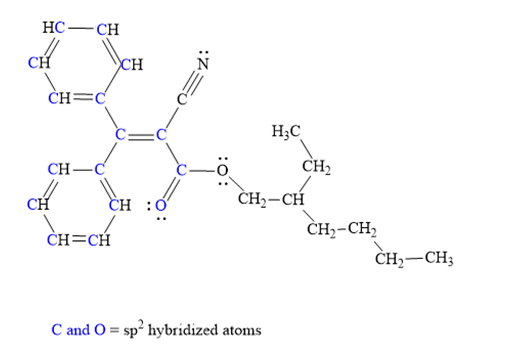
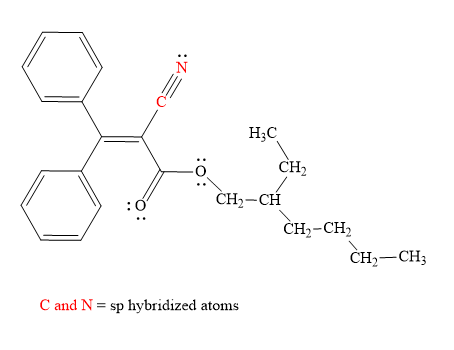
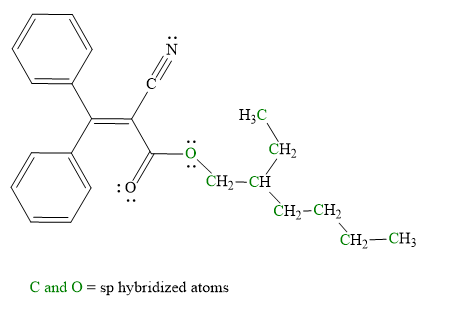
Explanation of Solution
The given structure for Octocrylene is:
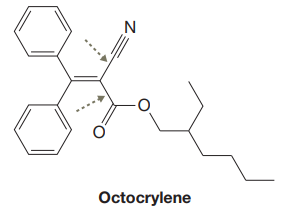
The above molecule has two benzene rings. Each carbon atom in the benzene ring has three electron groups: two single bonds and one double bond. Thus, the geometry for all these carbon atoms must be trigonal planar and hybridization must be

The triple bonded carbon atom has two electron groups: one single bond and one triple bond. Thus, the hybridization of this carbon atom must be

The single bonded oxygen atom and each carbon atom in the alkyl chain has four electrons groups. Thus, its geometry must be tetrahedral and hybridization must be

Hybridization of all non-hydrogen atoms is shown in three figures as above.
(b)
Interpretation:
All the atoms bonded to the acyclic
Concept introduction:
Free rotation can occur about single bonds but not about double bonds. According to the VSEPR theory, if an atom has three electron groups: three bonds, or two bonds and one pair of electrons then, the atom is said to be
Answer to Problem 3.54P
Explanation of Solution
The given structure for Octocrylene is:
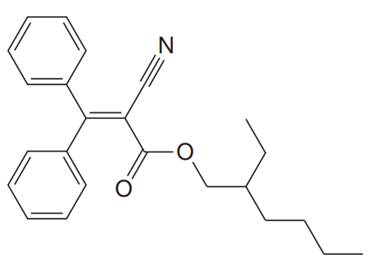
In the above structure, the
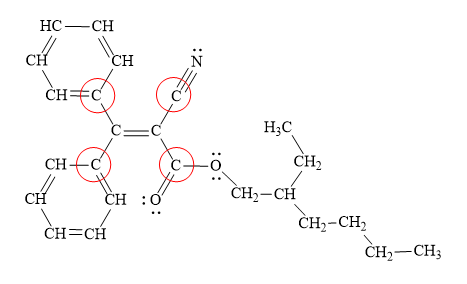
All the atoms bonded to the acyclic
(c)
Interpretation:
It is to be determined if there are two unique configurations possible about the acyclic
Concept introduction:
No free rotation takes place about the double bonds. Hence, in such compounds, molecules that differ by the exchange of two groups on one of the doubly bonded atoms are said to have different configurations. It is a cis configuration if the two non-hydrogen substituents are on present the same side of the double bond, and it is trans if they are on the opposite sides.
Answer to Problem 3.54P
It is not possible to have two unique configurations about the acyclic
Explanation of Solution
The given structure for Octocrylene is:
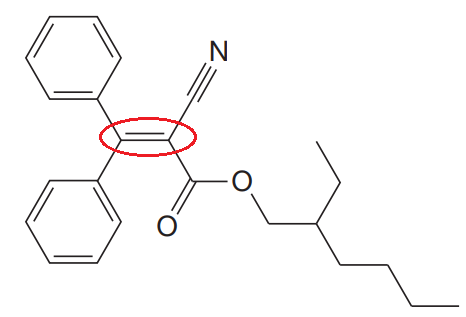
In the structure above, the acyclic
Thus, it is not possible to have two unique configurations about the acyclic
For a
(d)
Interpretation:
Out of the two indicated
Concept introduction:
The bond distance decrease and bond energies increase as the hybridization of the atom goes changes
Answer to Problem 3.54P
The
Explanation of Solution
The given structure for Octocrylene is:
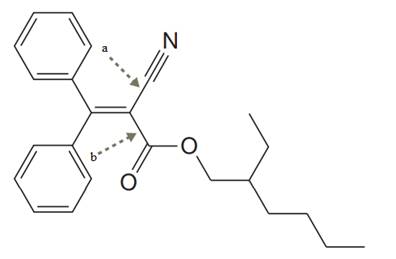
In the structure above, the two
The two carbon atoms involved in ‘a’ type of are
The two carbon atoms involved in ‘b’ type of bond are both
The bond distance decrease and bond energies increase as the hybridization of the atom goes changes
Want to see more full solutions like this?
Chapter 3 Solutions
Organic Chemistry: Principles And Mechanisms (second Edition)
- What is the reaction mechanism for this?arrow_forwardPredict the major products of both organic reactions. Be sure to use wedge and dash bonds to show the stereochemistry of the products when it's important, for example to distinguish between two different major products. esc esc Explanation Check 2 : + + X H₁₂O + Х ง WW E R Y qab Ccaps lock shift $ P X Click and drag to start drawing a structure. © 2025 McGraw Hill LLC. All Rights Reserved. Terms of Use | Privacy Center | Accessibility Bil T FR F18 9 G t K L Z X V B N M control opption command command T C darrow_forwardDraw the Markovnikov product of the hydrohalogenation of this alkene. this problem. Note for advanced students: draw only one product, and don't worry about showing any stereochemistry. Drawing dash and wedge bonds has been disabled for caps lock Explanation Check 2 W E R + X 5 HCI Click and drag to start drawing a structure. © 2025 McGraw Hill LLC. All Rights Reserved. Terms of Use | Privacy Center | Accessibility Bil Y F G H K L ZZ X C V B N M control opption command F10 F10 command 4 BA Ar Carrow_forward
- I don't understand why the amide on the top left, with the R attached to one side, doesn't get substituted with OH to form a carboxylic acid. And if only one can be substituted, why did it choose the amide it chose rather than the other amide?arrow_forwardesc Draw the Markovnikov product of the hydration of this alkene. Note for advanced students: draw only one product, and don't worry about showing any stereochemistry. Drawing dash and wedge bonds has been disabled for this problem. Explanation Check BBB + X 0 1. Hg (OAc)2, H₂O 2. Na BH 5 Click and drag to start drawing a structure. © 2025 McGraw Hill LLC. All Rights Reserved. Terms of Use | Privacy Center | Accessibility Bl P 豆 28 2 28 N 9 W E R T Y A S aps lock G H K L Z X C V B N M T central H command #e commandarrow_forwardC A student proposes the transformation below in one step of an organic synthesis. There may be one or more products missing from the right-hand side, but there are no reagents missing from the left-hand side. There may also be catalysts, small inorganic reagents, and other important reaction conditions missing from the arrow. • Is the student's transformation possible? If not, check the box under the drawing area. . If the student's transformation is possible, then complete the reaction by adding any missing products to the right-hand side, and adding required catalysts, inorganic reagents, or other important reaction conditions above and below the arrow. • You do not need to balance the reaction, but be sure every important organic reactant or product is shown. (X) This transformation can't be done in one step. + Tarrow_forward
- く Predict the major products of this organic reaction. If there aren't any products, because nothing will happen, check the box under the drawing area instead. No reaction. Explanation Check OH + + ✓ 2 H₂SO 4 O xs H₂O 2 Click and drag to start drawing a structure. © 2025 McGraw Hill LLC. All Rights Reserved. Terms of Use | Privacy Centerarrow_forwardDraw the skeletal ("line") structure of 1,3-dihydroxy-2-pentanone. Click and drag to start drawing a structure. X Parrow_forwardPredicting edict the major products of this organic reaction. If there aren't any products, because nothing will happen, check the box under the drawing area instead. + No reaction. Explanation Check HO Na O H xs H₂O 2 Click and drag to start drawing a structure. © 2025 McGraw Hill LLC. All Rights Reserved. Terms of Use | Privacy Center Iarrow_forward
- Choosing reagents and conditions for acetal formation or hydrolysis 0/5 A student proposes the transformation below in one step of an organic synthesis. There may be one or more products missing from the right-hand side, but there are no reagents missing from the left-hand side. There may also be catalysts, small inorganic reagents, and other important reaction conditions missing from the arrow. • Is the student's transformation possible? If not, check the box under the drawing area. If the student's transformation is possible, then complete the reaction by adding any missing products to the right-hand side, and adding required catalysts, inorganic reagents, or other important reaction conditions above and below the arrow. • You do not need to balance the reaction, but be sure every important organic reactant or product is shown. + This transformation can't be done in one step. 5 I H Autumn alo 值 Ar Barrow_forwardA block of copper of mass 2.00kg(cp = 0.3851 .K) and g temperature 0°C is introduced into an insulated container in which there is 1.00molH, O(g) at 100°C and 1.00 2 atm. Note that C P = 4.184. K for liquid water, and g that A H = 2260 for water. vap g Assuming all the steam is condensed to water, and that the pressure remains constant: (a) What will be the final temperature of the system? (b) What is the heat transferred from the water to the copper? (c) What is the entropy change of the water, the copper, and the total system?arrow_forwardIdentify the missing organic reactants in the following reaction: H+ X + Y OH H+ O O Note: This chemical equation only focuses on the important organic molecules in the reaction. Additional inorganic or small-molecule reactants or products (like H₂O) are not shown. In the drawing area below, draw the skeletal ("line") structures of the missing organic reactants X and Y. You may draw the structures in any arrangement that you like, so long as they aren't touching. Explanation Check Click and drag to start drawing a structure. X G 2025 McGraw Hill LLC. All Rights Reserved. Terms of Use | Privacy Cente ? Earrow_forward
 Chemistry: Principles and PracticeChemistryISBN:9780534420123Author:Daniel L. Reger, Scott R. Goode, David W. Ball, Edward MercerPublisher:Cengage Learning
Chemistry: Principles and PracticeChemistryISBN:9780534420123Author:Daniel L. Reger, Scott R. Goode, David W. Ball, Edward MercerPublisher:Cengage Learning Chemistry: The Molecular ScienceChemistryISBN:9781285199047Author:John W. Moore, Conrad L. StanitskiPublisher:Cengage Learning
Chemistry: The Molecular ScienceChemistryISBN:9781285199047Author:John W. Moore, Conrad L. StanitskiPublisher:Cengage Learning

